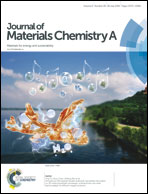Nanosheet-based magadiite: a controllable two-dimensional trap for selective capture of heavy metals†
Abstract
Long-chain imidazolium-based surfactants are assembled cooperatively with silicate clathrate anions to generate magadiite nanosheets, where the imidazole acts as a structure-directing agent for specific structures, while the surfactant tails regulate the distance of layers. Four different tails are selected among linear alkyl chains (CnH2n+1, n = 12, 16, 18, 22) to evaluate structure-directing effects with the formula of [tail-N+C5H8N]Br−. The well-crystallized nanosheet-based magadiites with controllable 2-dimensional rectangular layered structure are reported for the first time. The adsorption performances of these materials are investigated by removal of heavy metals, including Cu(II), Zn(II), Pb(II) and Cd(II). These materials manifest high adsorption capacity and different selectivities, especially for Cu(II) and Pb(II). The space and assembly of interlayers as well as the properties of heavy metals determine the removal efficiency and selectivity. Through a controllable interface, the as-synthesized samples could overcome the diffusion limit with enhanced selectivity and adsorption capacity, compared to conventional rosette-like magadiites. Nanosheet-based magadiites are promising adsorbents with controlled interlayer space and well-defined 2D structure, which make them new candidates for heavy metal removal and a platform to study the 2-dimensional plane trap effects between the silicate and metals.



 Please wait while we load your content...
Please wait while we load your content...